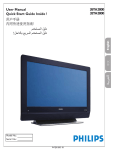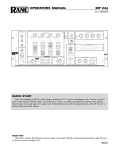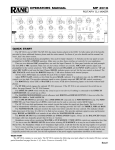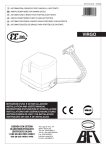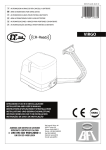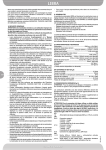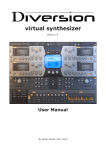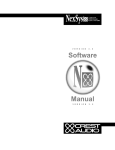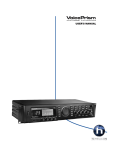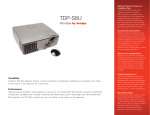Download MP 2016S / XP 2016S Manual
Transcript
Schematics are downloadable from dj.rane.com 1 5 1 10 0 0 +6 +6 +6 A POST B OFF OFF OFF 0 BASS MID TREBLE CUE 1 1 5 6 10 7 0 0 +6 +6 +6 CUE 2 BASS MID TREBLE A POST B OFF OFF OFF 0 2 AUX 2 AUX 1 1 5 6 10 7 0 0 +6 +6 +6 CUE 3 BASS MID TREBLE A POST B OFF OFF OFF 0 3 AUX 2 AUX 1 1 5 6 10 7 0 0 +6 +6 +6 CUE 4 BASS MID TREBLE A POST B OFF OFF OFF 0 4 AUX 2 AUX 1 1 5 6 10 7 0 0 +6 +6 +6 CUE 5 BASS MID TREBLE A POST B OFF OFF OFF 0 5 AUX 2 AUX 1 4 1 10 0 0 +6 +6 +6 CUE 6 BASS MID TREBLE A POST B OFF OFF OFF 0 6 MIX LEVEL 9 7 2 6 SIG / OL 8 5 8 9 7 10 6 ENGAGE MIC 2 3 4 1 5 6 INPUT GAIN 2 3 AUX 5 AUX 4 AUX 3 SIG / OL 8 9 8 9 7 10 6 ENGAGE MIC 1 INPUT GAIN 1 5 5 MIX LEVEL 4 2 3 4 2 3 AUX 5 AUX 4 AUX 3 SIG / OL 8 9 8 9 7 10 6 PHONO / LINE INPUT GAIN 1 5 4 MIX LEVEL 4 2 3 4 2 3 AUX 5 AUX 4 AUX 3 SIG / OL 8 9 8 9 7 10 6 PHONO / LINE INPUT GAIN 1 5 3 MIX LEVEL 4 2 3 4 2 3 AUX 5 AUX 4 AUX 3 SIG / OL 8 9 8 9 7 10 6 INPUT GAIN 1 5 PHONO / LINE MIX LEVEL 4 2 3 4 2 3 AUX 5 2 2 3 4 6 PGM A F 60X 10 0 8 2 10 4 2 3 8 9 6 4 4 6 8 2 8 0 10 RIGHT / PGM LEFT / CUE 0 0 +6 +6 +6 PHONES OFF OFF OFF 0 BASS MID B ROTARY MIXER EXTERNAL PROCESSOR XP 2016S MP 2016S TREBLE CROSSFADER CONTOUR POWER POWER SIG / OL 9 7 10 6 LEVEL 1 5 STEREO MONO 7 0 +2 +4 +7 +10 CUE METER STEREO 6 HOUSE 1 5 EFFECTS LOOP 2 3 4 MONO -20 -10 -7 -4 -2 MONITOR CUE 8 4 8 2 6 2 8 9 6 4 MASTER CUE 7 MASTER XP 2016S 10 BOOTH 1 5 ROTARY MIXER 1 MIX LEVEL 9 7 2 6 8 5 SIG / OL 3 4 INPUT GAIN 10 9 2 7 8 6 3 4 AUX 5 AUX 4 AUX 2 AUX 1 AUX 4 PHONO / LINE AUX 3 1 AUX 3 AUX 2 AUX 1 MP 2016S XP 2016S EXTERNAL PROCESSOR IMPORTANT SAFETY INSTRUCTIONS 1. Read these instructions. 2. Keep these instructions. 3. Heed all warnings. 4. Follow all instructions. 5. Do not use this apparatus near water. 6. Clean only with a dry cloth. 7. Do not block any ventilation openings. Install in accordance with manufacturer’s instructions. 8. Do not install near any heat sources such as radiators, registers, stoves, or other apparatus (including amplifiers) that produce heat. 9. Do not defeat the safety purpose of the polarized or grounding-type plug. A polarized plug has two blades with one wider than the other. A grounding-type plug has two blades and a third grounding prong. The wide blade or third prong is provided for your safety. If the provided plug does not fit into your outlet, consult an electrician for replacement of the obsolete outlet. 10. Protect the power cord and plug from being walked on or pinched particularly at plugs, convenience receptacles, and the point where it exits from the apparatus. 11. Only use attachments and accessories specified by Rane. 12. Use only with the cart, stand, tripod, bracket, or table specified by the manufacturer, or sold with the apparatus. When a cart is used, use caution when moving the cart/apparatus combination to avoid injury from tip-over. 13. Unplug this apparatus during lightning storms or when unused for long periods of time. 14. Refer all servicing to qualified service personnel. Servicing is required when the apparatus has been damaged in any way, such as power supply cord or plug is damaged, liquid has been spilled or objects have fallen into the apparatus, the apparatus has been exposed to rain or moisture, does not operate normally, or has been dropped. 15. The plug on the power cord is the AC mains disconnect device and must remain readily operable. To completely disconnect this apparatus from the AC mains, disconnect the power supply cord plug from the AC receptacle. 16. This apparatus shall be connected to a mains socket outlet with a protective earthing connection. 17. When permanently connected, an all-pole mains switch with a contact separation of at least 3 mm in each pole shall be incorporated in the electrical installation of the building. 18. If rackmounting, provide adequate ventilation. Equipment may be located above or below this apparatus, but some equipment (like large power amplifiers) may cause an unacceptable amount of hum or may generate too much heat and degrade the performance of this apparatus. 19. This apparatus may be installed in an industry standard equipment rack. Use screws through all mounting holes to provide the best support. WARNING: To reduce the risk of fire or electric shock, do not expose this apparatus to rain or moisture. Apparatus shall not be exposed to dripping or splashing and no objects filled with liquids, such as vases, shall be placed on the apparatus. WARNING The symbols shown below are internationally accepted symbols that warn of potential hazards with electrical products. CAUTION RISK OF ELECTRIC SHOCK DO NOT OPEN ATTENTION: RISQUE DE CHOCS ELECTRIQUE - NE PAS OUVRIR To reduce the risk of electrical shock, do not open the unit. No user serviceable parts inside. Refer servicing to qualified service personnel. This symbol indicates that a dangerous voltage constituting a risk of electric shock is present within this unit. This symbol indicates that there are important operating and maintenance instructions in the literature accompanying this unit. WARNING: This product may contain chemicals known to the State of California to cause cancer, or birth defects or other reproductive harm. NOTE: This equipment has been tested and found to comply with the limits for a Class B digital device, pursuant to part 15 of the FCC Rules. These limits are designed to provide reasonable protection against harmful interference in a residential installation. This equipment generates, uses and can radiate radio frequency energy and, if not installed and used in accordance with the instructions, may cause harmful interference to radio communications. However, there is no guarantee that interference will not occur in a particular installation. If this equipment does cause harmful interference to radio or television reception, which can be determined by turning the equipment off and on, the user is encouraged to try to correct the interference by one or more of the following measures: • Reorient or relocate the receiving antenna. • Increase the separation between the equipment and receiver. • Connect the equipment into an outlet on a circuit different from that to which the receiver is connected. • Consult the dealer or an experienced radio/TV technician for help. CAUTION: Changes or modifications not expressly approved by Rane Corporation could void the user's authority to operate the equipment. This Class B digital apparatus complies with Canadian ICES-003. Cet appareil numérique de la classe B est conforme à la norme NMB-003 du Canada. INSTRUCTIONS DE SÉCURITÉ 1. Lisez ces instructions. 2. Gardez précieusement ces instructions. 3. Respectez les avertissements. 4. Suivez toutes les instructions. 5. Ne pas utiliser près d’une source d’eau. 6. Ne nettoyer qu’avec un chiffon doux. 7. N’obstruer aucune évacuation d’air. Effectuez l’installation en suivant les instructions du fabricant. 8. Ne pas disposer près d’une source de chaleur, c-à-d tout appareil produisant de la chaleur sans exception. 9. Ne pas modifier le cordon d’alimentation. Un cordon polarisé possède 2 lames, l’une plus large que l’autre. Un cordon avec tresse de masse possède 2 lames plus une 3è pour la terre. La lame large ou la tresse de masse assurent votre sécurité. Si le cordon fourni ne correspond pas à votre prise, contactez votre électricien. 10. Faites en sorte que le cordon ne soit pas piétiné, ni au niveau du fil, ni au niveau de ses broches, ni au niveau des connecteurs de vos appareils. 11. N’utilisez que des accessoires recommandés par Rane. 12. N’utilisez que les éléments de transport, stands, pieds ou tables spécifiés par le fabricant ou vendu avec l’appareil. Quand vous utlisez une valise de transport, prenez soin de vous déplacer avec cet équipement avec prudence afin d’éviter tout risque de blessure. 13. Débranchez cet appareil pendant un orage ou si vous ne l’utilisez pas pendant un certain temps. 14. Adressez-vous à du personnel qualifié pour tout service après vente. Celui-ci est nécessaire dans n’importe quel cas où l’appareil est abimé : si le cordon ou les fiches sont endommagés, si du liquide a été renversé ou si des objets sont tombés sur l’appareil, si celui-ci a été exposé à la pluie ou l’humidité, s’il ne fonctionne pas correctement ou est tombé. 15. La fiche du cordon d’alimentation sert à brancher le courant alternatif AC et doit absolument rester accessible. Pour déconnecter totalement l’appareil du secteur, débranchez le câble d’alimentation de la prise secteur. 16. Cet appareil doit être branché à une prise terre avec protection. 17. Quand il est branché de manière permanente, un disjoncteur tripolaire normalisé doit être incorporé dans l’installation électrique de l’immeuble. 18. En cas de montage en rack, laissez un espace suffisant pour la ventilation. Vous pouvez disposer d’autres appareils au-dessus ou en-dessous de celuici, mais certains (tels que de gros amplificateurs) peuvent provoquer un buzz ou générer trop de chaleur au risque d’endommager votre appareil et dégrader ses performances. 19. Cet appareil peut-être installé dans une baie standard ou un chassis normalisé pour un montage en rack. Visser chaque trou de chaque oreille de rack pour une meilleure fixation et sécurité. ATTENTION: afin d’éviter tout risque de feu ou de choc électrique, gardez cet appareil éloigné de toute source d’humidité et d’éclaboussures quelles qu’elles soient. L’appareil doit également être éloigné de tout objet possédant du liquide (boisson en bouteilles, vases,…). ATTENTION CAUTION RISK OF ELECTRIC SHOCK DO NOT OPEN ATTENTION: RISQUE DE CHOCS ELECTRIQUE - NE PAS OUVRIR Afin d’éviter tout risque de choc électrique, ne pas ouvrir l’appareil. Aucune pièce ne peut être changée par l’utilisateur. Contactez un SAV qualifié pour toute intervention. Les symboles ci-dessous sont reconnus internationalement comme prévenant tout risque électrique. Ce symbole indique que cette unité utilise un voltage élevé constituant un risque de choc électrique. Ce symbole indique la présence d’instructions d’utilisation et de maintenance importantes dans le document fourni. REMARQUE: Cet équipement a été testé et approuvé conforme aux limites pour un appareil numérique de classe B, conformément au chapitre 15 des règles de la FCC. Ces limites sont établis pour fournir une protection raisonnable contre tout risque d’interférences et peuvent provoquer une énergie de radiofréquence s'il n'est pas installé et utilisé conformément aux instructions, peut également provoquer des interférences aux niveaux des équipements de communication. Cependant, il n'existe aucune garantie que de telles interférences ne se produiront pas dans une installation particulière. Si cet équipement provoque des interférences en réception radio ou télévision, ceci peut être detecté en mettant l'équipement sous/hors tension, l'utilisateur est encouragé à essayer de corriger cette interférence par une ou plusieurs des mesures suivantes: • Réorienter ou déplacer l'antenne de réception. • Augmenter la distance entre l'équipement et le récepteur. • Connecter l'équipement à une sortie sur un circuit différent de celui sur lequel le récepteur est branché. • Consulter un revendeur ou un technicien radio / TV expérimenté. ATTENTION: Les changements ou modifications non expressément approuvés par Rane Corporation peuvent annuler l'autorité de l'utilisateur à manipuler cet équipement et rendre ainsi nulles toutes les conditions de garantie. Cet appareil numérique de classe B est conforme à la norme Canadienne ICES-003. Cet appareil numérique de classe B est conforme à la norme Canadienne NMB-003. OPERATORS MANUAL MP 2016S ROTARY DJ MIXER 1 AUX 1 2 PHONO / LINE AUX 2 AUX 1 3 PHONO / LINE AUX 2 AUX 1 4 PHONO / LINE AUX 2 AUX 1 5 PHONO / LINE AUX 2 AUX 1 AUX 3 AUX 3 AUX 3 AUX 3 AUX 4 AUX 4 AUX 4 AUX 4 AUX 4 AUX 5 5 4 6 7 3 4 8 2 6 7 3 9 1 AUX 5 5 4 8 2 SIG / OL 10 INPUT GAIN 6 7 3 9 1 AUX 5 5 2 SIG / OL 4 8 10 1 INPUT GAIN 6 10 1 INPUT GAIN 6 2 SIG / OL 10 1 INPUT GAIN 6 10 1 INPUT GAIN OFF SIG / OL 9 1 5 5 6 7 4 2 1 10 5 7 CUE 1 1 10 5 7 3 9 MIX LEVEL 6 4 8 2 9 MIX LEVEL 6 4 3 8 2 CUE 2 1 10 5 7 3 9 MIX LEVEL 6 4 8 EFFECTS LOOP OFF MONO SIG / OL 2 CUE 3 9 1 10 MIX LEVEL 5 MASTER CUE 4 1 10 CUE 5 4 1 10 2 4 CUE 6 8 CUE MONO MP 2016S STEREO 6 +6 ROTARY MIXER 7 8 3 2 9 1 PGM MONITOR 5 4 6 8 9 MIX LEVEL 2 BASS STEREO 6 8 2 9 MIX LEVEL 7 3 8 2 6 4 7 3 +6 0 10 INPUT GAIN 6 4 8 MID 10 OFF 3 +6 0 HOUSE XP 2016S CUE 9 8 2 10 8 2 SIG / OL 7 3 BOOTH 7 3 9 8 9 TREBLE 6 4 3 1 5 4 8 5 7 2 7 3 9 ENGAGE AUX 5 5 4 8 2 SIG / OL AUX 3 AUX 4 7 3 9 ENGAGE 0 6 4 AUX 2 AUX 5 5 MASTER 5 MIC 2 AUX 1 AUX 2 AUX 3 AUX 5 6 MIC 1 10 POWER LEVEL PHONES QUICK START The MP 2016S has Split Cue! If you don’t know what that is, we suggest you take the time to read this entire manual so you learn lots of other things to get the best sound and features out of your new mixer. But if you know what Split Cue is, at least read this section to refresh your knowledge of the rest of the MP 2016S. There are four dedicated phono preamplifiers. One each for Input channels 1-4. Switches on the rear panel set each preamplifier for LINE or PHONO operation. Make sure you have these switches set correctly for your application. There are two dedicated MIC preamplifiers, one each for Input channels 5-6. Rear panel switches set each preamplifier for LINE or MIC operation. Make sure you have these switches set correctly. MIC GAIN controls adjust each preamplifier for the correct sensitivity. With a MIC selected and ENGAGED, set the front INPUT GAIN control to “10” and adjust the rear MIC GAIN to just keep the Input Channel SIG / OL indicator green, not red. Set the rear panel tone controls as desired. The MIC ENGAGE switch ducks the BOOTH Output by 12 dB unless defeated with internal jumpers. Before installing this mixer permanently, be sure to read the MIC / LINE INPUTS section on page Manual-6. All five stereo line-level AUX Inputs are available for each of the six Input Channels. Adjust the INPUT GAIN controls so they blink the green SIG / OL indicators. If an indicator is red, the INPUT GAIN control is set too high. This provides optimum signal to noise, dynamic range and MIX LEVEL control consistency. The BOOTH may select CUE or MASTER as its source. CUE allows monitoring Inputs in the booth without headphones. The XP 2016S switch engages the optional XP 2016S processor. If the XP 2016S is not connected, the switch has no effect. The EFFECTS LOOP switch switches the Loop in (up) or out (down). If nothing is connected to the EFFECTS LOOP RETURN, the switch has no effect. The MASTER MONO / STEREO switch influences both BOOTH and HOUSE OUTPUTS. It does not affect the EFFECTS LOOP or TAPE OUTPUTS. Two TAPE OUTPUTS are provided. One is a PRE-EFFECTS Loop and one is a POST-EFFECTS Loop. The POSTEFFECTS Loop Tape Output has a LEVEL control and may be used as a pre-tone control AUX Output. The MP 2016S Master Output uses Accelerated Slope ™ tone controls that provide full “kill” for TREBLE, MID and BASS. The MASTER SIG / OL indicator monitors the master mix before and after the tone controls. This indicator should light green most of the time. It is OK for it to flash red on occasion. This provides optimum signal-to-noise and dynamic range. HOUSE and BOOTH are the only level controls that do not affect the MASTER SIG / OL indicator. The HOUSE OUTPUT has both balanced (XLR) and unbalanced (RCA) Outputs. To avoid hum, always use the balanced (XLR) Outputs for longer cable runs (typically greater than 10 feet, or 3 meters). Headphone cueing allows monitoring MASTER or CUE sources. If MIX LEVEL controls are operated at less than “7”, be sure to turn the PHONES LEVEL down before selecting a CUE as it may be much louder than the Master Mix. The Headphone Output is low-impedance high-current, so do not short the tip and ring together or to ground. WEAR PART The MP 2016S contains no wear parts. The XP 2016S contains the following wear part subject to the ninety (90) day warranty period described on page Service-1: (1) Active Crossover Assembly F 60X. Manual-1 MP 2016S FRONT PANEL CONTROLS 1 2 PHONO / LINE AUX 1 AUX 2 AUX 1 3 PHONO / LINE AUX 2 AUX 1 4 PHONO / LINE AUX 2 PHONO / LINE AUX 2 AUX 1 AUX 3 AUX 3 AUX 3 AUX 3 AUX 4 AUX 4 AUX 4 AUX 4 AUX 4 AUX 5 5 4 6 7 2 5 4 8 3 AUX 5 6 8 3 9 2 AUX 5 5 4 7 6 8 3 9 2 3 8 2 3 9 1 8 2 10 10 1 AUX 1 2 PHONO / LINE AUX 2 AUX 1 PHONO / LINE AUX 2 ENGAGE 8 8 3 8 AUX 2 AUX 2 AUX 2 AUX 3 AUX 3 AUX 4 AUX 4 AUX 5 3 9 1 5 6 5 3 8 1 2 9 10 MIX LEVEL 6 5 7 2 CUE 1 10 MIX LEVEL 8 2 CUE 9 SIG / OL 3 MASTER 5 8 10 6 MIX LEVEL INPUT GAIN INPUT GAIN controls allow the user to match input levels. Adjust these to make the SIG / OL indicator flash green. If the indicators turn red, reduce the INPUT GAIN. Adjusting the INPUT LEVEL controls correctly maximizes dynamic range and provides consistent MIX LEVEL response. Input SIG / OL These dual-color indicators provide help in setting correct input levels. A flashing green indication is optimal. A red light that lasts more than a flash is a request to turn down the INPUT GAIN. 5 2 CUE 3 MIX LEVEL 5 5 7 10 CUE MASTER MIX LEVEL 6 7 3 4 10 MIX LEVEL 2 8 9 1 2 6 8 2 CUE 5 10 SIG / OL 10 4 9 1 3 8 6 8 6 4 BOOTH 9 1 2 CUE 4 MONITO INPUT GAIN 3 9 10 CUE 7 2 SIG / OL 10 4 6 3 8 6 8 8 1 5 4 7 9 1 7 1 6 2 2 INPUT GAIN 3 9 1 5 2 SIG / OL 10 4 ENGAGE AUX 5 3 8 6 7 AUX 3 2 4 8 AUX 4 4 10 BOOTH 7 3 SIG / OL ENGAGE 7 9 1 2 CUE 2 6 AUX 2 INPUT GAIN 3 9 1 6 2 SIG / OL 10 4 8 5 3 9 INPUT GAIN 3 8 9 AUX 5 4 7 8 10 4 6 2 SIG / OL INPUT GAIN 7 1 9 1 5 3 8 10 AUX 5 4 7 2 SIG / OL INPUT GAIN 4 6 3 8 2 AUX 5 5 1 5 4 8 AUX 4 4 3 2 7 3 AUX 3 7 ENGAGE INPUT SELECTORS 5-6 1 10 1 10 1 10 Each six-position chooses a dedicated mono INPUT GAINInput Selector INPUT GAIN INPUT GAIN MIC Input, or one of five stereo AUX Inputs as its Input Channel source. (MIC GAIN trim, MIC / LINE switch and MIC tone 5 6 5 6 5 6 controls 4are located 7 7 on the rear 4 4 panel).7 AUX 4 6 6 2 AUX 3 5 5 3 SIG / OL AUX 4 4 AUX 3 6 4 AUX 5 4 9 5 MIC 2 AUX 4 7 AUX 3 AUX 5 AUX 1 AUX 2 MIC ENGAGE 2 9 2 9 2 9 2 9 MIC 1 and a10mic on 1 1 10 1 MIC 102 ENGAGE 1switches 10 allow switching CUE CUE CUE CUE (down). Input and MIC EN-6 MIX LEVEL (up) 3 or off MIX LEVEL A MIC 4 MIXmust LEVELbe selected 5 MIX LEVEL GAGE on to activate a MIC Input. When a mic is not in use, be sure to switch MIC ENGAGE off. The MIC ENGAGE switches also activate the Booth Ducker. This attenuates the Booth Output -12 dB whenever a MIC ENGAGE switch is on, even if MIC 3 4 5 6 Input is not selected (internal jumpers allow disabling the Booth MIC 2 AUX 1 PHONO / AUX 1 PHONO / AUX 1 MIC 1 AUX 1 Ducker—see Mic/Line Inputs on page Manual-6). LINE LINE CUE 2 MIX LEVEL 6 2 SIG / OL 3 9 1 CUE 1 MIX LEVEL SIG / OL 5 3 9 INPUT SELECTORS 1-4 1 10 1 10 1 10 Each six-positionINPUT Input Selector chooses a GAIN dedicated PHONO / GAIN INPUT INPUT GAIN LINE preamplifier, or one of five stereo line-level AUX Inputs as its Input Channel source. (PHONO / LINE switches are on the 5 6 5 6 5 6 rear panel). 7 7 7 4 4 4 SIG / OL MIC 1 AUX 5 4 7 6 AUX 2 AUX 3 AUX 5 Manual-2 AUX 1 5 CUE 6 MIX LEVEL These studio-grade controls determine the Master MIX LEVEL. For optimum performance, set the INPUT GAIN controls as indicated previously, and then operate MIX LEVELS between “7” and “10” for full volume. Use the HOUSE and BOOTH LEVEL controls to set the output levels. Always set the MIX LEVEL controls to minimum when not in use. CUE The CUE signal is selected using CUE 1-6 switches in any combination. The associated yellow indicator lights when a CUE is active. CUE MONITO MASTER HOUSE Level This studio-grade control sets the HOUSE Output level. 6 MASTER 5 MIC 2 6 5 7 4 ENGAGE 8 8 OFF SIG / OL 9 1 0 OFF MONO MASTER GAIN 6 7 4 EVEL 2 2 4 6 8 CUE MONO MP 2016S STEREO 6 +6 ROTARY MIXER 7 8 3 2 9 1 PGM MONITOR 5 4 6 8 CUE 6 BASS STEREO OFF 9 +6 0 10 10 MID HOUSE SIG / OL 8 +6 10 EFFECTS XP 2016S LOOP CUE 9 8 2 10 BOOTH 7 7 3 9 1 MASTER MONO / STEREO switch This sets the MASTER mix signal to MONO or STEREO operation. It effects both BOOTH and HOUSE Outputs. TREBLE 6 4 3 2 6 0 10 POWER LEVEL PHONES HEADPHONE MONITOR MONITOR determines the source of the PHONES signal. With the MONITOR MONO switch out, the control pans between stereo CUE and stereo PGM signals. The PGM signal follows the HOUSE Output (same signal going to the Master House). With MONITOR MONO selected (in), the MONITOR control pans between mono CUE (left ear) and mono PGM (right ear). The Phones LEVEL control determines the headphone output level. If you are mixing with the MIX LEVEL controls below “7”, be sure to turn the Phones LEVEL down before selecting a CUE source as it may be much louder than the Master Mix. The PHONES output is very low impedance and high current so do not short tip and ring together or tie to ground, as is common with many low- cost mono cups. Use resistors of 300 to 600 Ω in series with each output for mono applications, although this significantly reduces output power. BOOTH T = LEFT CUE / MASTER switch and Level R = RIGHT S = GROUND TO MONO PHONE MASTER SIG / OL indicator This dual color indicator helps set correct MASTER mix levels. A flashing or steady green indication is optimal. The red indicator may flash only briefly on rare occasion...regular flashing or steady-on means that distortion is imminent and Levels need reducing. XP 2016S switch This engages the optional XP 2016S External Processor. If the XP 2016S is not connected, the switch does nothing. If an XP 2016S is connected and the switch is on (up), it routes the MIX LEVEL Outputs to the XP 2016S and returns a stereo MASTER signal to the MP 2016S. EFFECTS LOOP switch This engages the EFFECTS LOOP when up. If nothing is connected to the EFFECTS LOOP RETURN, the switch has no effect. TREBLE tone control Allows adjusting the amplitude of frequencies above 4 kHz from +6 dB to OFF (full kill). MID tone control Allows adjusting the amplitude of frequencies between 300 Hz and 4 kHz from +6 dB to OFF (full kill). BASS tone control Allows adjusting the amplitude of frequencies below 300 Hz from +6 dB to OFF (full kill). POWER indicator This yellow indicator lights whenever AC power is connected to the unit. AUDIO PRECISION 10 Low 0, Mid 0, High 0 5 The BOOTH CUE / MASTER switch selects MASTER mix or CUE selection as the Booth source. This allows CUE monitoring in the Booth without headphones. The BOOTH Level controls the volume to the Booth Output. AMPL(dBr) vs FREQ(Hz) Summed Response 0 Low -5 Mid -10 Low 0, Mid Off, High Off -15 -20 High Low Off, Mid 0, High Off Low Off, Mid Off, High 0 -25 -30 -35 -40 20 100 1k 10k 50k Treble, Mid and Bass control bands and the flat summed response Manual-3 REAR PANEL INPUTS & OUTPUTS MIC 2 MP 2016S BASS TREBLE MADE IN U.S.A. RANE CORP. U.S. PATENT 7,043,032 0 0 -12 ACN 001 345 482 +12 -12 GAIN +12 MIC 1 100-240 V 50/60 Hz 12 WATTS 0 -12 HOUSE OUTPUTS +12 -12 GAIN MIC LINE 3 BOOTH OUTPUTS 2 1 L L L R R R R +12 EFFECTS LOOP RETURN INPUTS L LINE PHONO This device complies with Part 15 of the FCC Rules. Operation is subject to the following two conditions: (1) this device may not cause harmful interference, and (2) this device must accept any interference received, including interference that may cause undesired operation. PIN 2 = POSITIVE PIN 3 = NEGATIVE PIN 1 = CHASSIS GROUND R TREBLE 0 MIC LINE XLR WIRING COMMERCIAL AUDIO EQUIPMENT 24TJ BASS 4 SEND MIC 1 and MIC 2 XLR jacksLEFT RIGHT L The MIC 1 Input provides a dedicated balanced preamplifier LEFT L LEVEL for Input Channel 5, while MIC 2 provides the preamplifier for R mode. RIGHT 6. Each may operate in MIC R Input Channels or LINE Each of these preamplifiers features GAIN trim with BASS and TREBLE tone controls. MIC / LINE switches These select MIC or LINE mode for the MIC Inputs. In MIC mode, the gain range is 20 to 50 dB. In LINE mode, the gain range is 0 to 30 dB. In addition to setting the proper gain range for MIC or LINE level Inputs, these switches also select the proper Input impedance. TAPE OUTPUTS — PHONO GROUND — XP 2016S EXTERNAL PROCESSOR AUX INPUTS INPUTS 1-4 RCA jacks 5 4 3 2 1 INPUTS 1-4 provide dedicated preamplifiers for Input Channels L L L L L L 1-4 respectively. Each may operate in RIAA PHONO or LINE R R R R R mode.R POST PRE EFFECTS EFFECTS PHONO / LINE switches These switches set Input Channel preamplifiers 1-4 for PHONO or LINE mode. Make certain these switches are set correctly for your source. PHONO GROUND These lugs are provided to connect ground wires from turntables. When using a turntable, proper grounding is essential. MIC GAIN trim These controls adjust the preamplifier for optimum dynamic range. Each has a range of 30 dB, allowing a wide range of sources to be used. To properly set this control, set the associated front panel INPUT GAIN to “10”, turn the MIC ENGAGE switch on and adjust the MIC GAIN so that the input SIG / OL indicator flashes red only during very loud peaks. The front panel INPUT GAIN control can then be adjusted as required according to the instruction outlined above under INPUT GAIN control. MIC TREBLE and BASS controls Separate TREBLE and BASS tone controls are provided for each MIC preamplifier. These allow adjustment of the tonal response of each Mic or Line source at the MIC Inputs. If you add a significant amount of boost, you may need to readjust the rear panel GAIN trims as outlined before. Manual-4 IMPORTANT NOTE: CHASSIS GROUNDING If after hooking up your system it exhibits excessive hum or buzzing, there is an incompatibility in the grounding configuration between units somewhere. If your equipment is in a rack, verify that all chassis are tied to a good earth ground, either through the line cord grounding pin or the rack screws to another grounded chassis. Please refer to the RaneNote “Sound System Interconnection” supplied with this manual and available from our website for further information on system grounding. MADE IN U.S.A. RANE CORP. U.S. PATENT 7,043,032 -12 ACN 001 345 482 GAIN 0 0 +12 -12 0 MIC LINE +12 -12 XLR WIRING HOUSE OUTPUTS R RIGHT 100-240 V 50/60 Hz 12 WATTS +12 -12 MIC LINE L L L R R R BOOTH OUTPUTS LEFT EFFECTS LOOP RETURN TAPE OUTPUTS SEND POST PRE EFFECTS EFFECTS L LEFT L RIGHT R L R +12 LINE PHONO This device complies with Part 15 of the FCC Rules. Operation is subject to the following two conditions: (1) this device may not cause harmful interference, and (2) this device must accept any interference received, including interference that may cause undesired operation. PIN 2 = POSITIVE PIN 3 = NEGATIVE PIN 1 = CHASSIS GROUND COMMERCIAL AUDIO EQUIPMENT 24TJ GAIN 0 LEVEL R EFFECTS LOOP SEND ¼" jacks SEND Outputs are unbalanced standard ¼" tip-sleeve jacks. They provide a line level Output for external signal processing or effects units. If effects are not being used, these outputs may be used as Auxiliary Outputs. EFFECTS LOOP RETURN ¼" jacks RETURN Inputs are unbalanced standard ¼" tip-sleeve jacks. They provide the Input from external signal processing or effects units. Switching jacks are used so there is no loss of signal if the front panel EFFECTS LOOP switch is active with no effects connected. RETURN Inputs are not appropriate for Auxiliary Inputs as this signal is only selected when the front panel EFFECTS LOOP switch is active, at which time Master signal is derived only by the signal present at the RETURN Inputs, the mix signals are disconnected. BOOTH OUTPUT RCA jacks The unbalanced stereo BOOTH OUTPUT is normally used for booth monitoring. As previously outlined, very flexible source selection is provided as well as MIC ducking. Remember, the BOOTH OUTPUT is attenuated by 12 dB whenever one of the front panel MIC ENGAGE switches is active (unless ducking has been defeated with the internal jumper. See Mic/Line Inputs on page Manual-6). HOUSE OUTPUT jacks Both balanced (XLR) and unbalanced (RCA) jacks are provided. For long runs, we highly recommend using the balanced XLR outputs. The unbalanced RCA outputs are intended for short runs of less than 10 feet (3 meters). Both may be used simultaneously if required. — PHONO GROUND — AUX INPUTS XP 2016S EXTERNAL PROCESSOR 5 4 3 2 1 L L L L L L R R R R R R AUX INPUTS 1-5 RCA jacks These five stereo AUX Inputs are unbalanced, line level Inputs available for selection on all six Input channels. XP 2016S EXTERNAL PROCESSOR The XP 2016S port provides the required socket for connecting the ribbon cable (supplied with the optional XP 2016S). If an XP 2016S is not connected, the front panel XP 2016S engage switch has no effect. If ribbons longer than that supplied with the XP 2016S are used, crosstalk may increase and immunity to RF, magnetic and conducted interference may be compromised — don’t do it. TAPE OUTPUT – PRE-EFFECTS RCA jacks This unbalanced line-level Output is located before the EFFECTS LOOP and tone controls for recording the Master Mix. MIC Inputs are mixed as any other source and will be present at both TAPE OUTPUTS. TAPE OUTPUT – POST-EFFECTS RCA jacks This unbalanced line-level Output is located after the EFFECTS LOOP and before the tone controls. This may be used as an Auxiliary Output. For this application, as well as for more flexibility when recording, a LEVEL control has been provided as described below. MIC 2 MP 2016S BASS BASS TREBLE TREBLE TAPE OUTPUT – POST-EFFECTS GAIN LEVEL control 0 0 0 0 MIC LINE This adjusts the POST-EFFECTS TAPE OUTPUT from unity gain to off, allowing optimum -12 +12 -12 +12 -12 +12 -12 +12 sensitivity adjustment for recording or for an Auxiliary Output. MADE IN U.S.A. RANE CORP. U.S. PATENT 7,043,032 ACN 001 345 482 XLR WIRING This device complies with Part 15 subject to the following two condition harmful interference, and (2) this dev received, including interference that m PIN 2 = POSITIVE PIN 3 = NEGATIVE PIN 1 = CHASSIS GROUND COMMERCIAL AUDIO EQUIPMENT 24TJ R 100-240 V 50/60 Hz 12 WATTS GAIN IEC320-C5 power jack BOOTH EFFECTS LOOP HOUSE OUTPUTS SEND Connects with the properOUTPUTS power cableRETURN to RIGHT LEFT AC line voltage anywhere in the world, L LEFT L 100-240 VAC. RIGHT R R Manual-5 L OPERATION RIAA PHONO/LINE INPUTS Input channels 1 through 4 each have a dedicated preamplifier. A rear panel switch allows setting these preamps for PHONO or LINE level signals. Make sure you have the switch in the correct position for your application. The source selectors for Input channels 1 - 4 may select the dedicated PHONO / LINE preamplifier or one of the five stereo AUX Inputs as the source. With normal program material playing, set the INPUT GAIN control to a level that causes the SIG / OL indicator to flash green. The SIG / OL indicator should not flash red. This will ensure optimum signal to noise ratio and dynamic range. If INPUT GAIN controls are set too high, you may not have the required headroom for mixing multiple Inputs. If your levels are set too low, signal-to-noise ratio is compromised. In addition to optimizing noise and dynamic range, properly setting INPUT GAIN allows the MIX LEVEL control to operate predictably over its entire range. The taper of the MIX LEVEL control is non-linear and will have different attenuation verses rotation characteristics depending on its position. As can be seen in the figure below, if you are mixing between 30% and 60% of rotation, MIX LEVEL will behave much differently than if operated between 65% and 95% of rotation. 10 20 30 40 50 60 70 80 90 100 90 80 70 60 50 40 30 20 10 0 100 Attenuation Mix Level Taper Rotation MIC / LINE INPUTS Input channels 5 and 6 each have dedicated preamplifiers. A rear panel switch allows setting these Inputs for MIC or LINE level signals. Make sure you have the switch in the correct position for your application. While these Inputs are designed for use with dynamic microphones (no phantom power) or wireless microphones with line level output, they will accept just about any mono signal. While balanced operation is highly recommended, these Inputs may be operated unbalanced with short cables to the source (less than 10 feet or 3 meters). The source selectors for Input channels 5 and 6 may select the dedicated MIC / LINE preamplifier or one of the five stereo AUX inputs. Prior to permanent installation, adjust the preamplifier GAIN, BASS and TREBLE controls (located on the rear panel) for the intended source. In addition to the MIC / LINE switch, each preamplifier has a rear panel MIC GAIN trim. To properly set the MIC GAIN, set the front panel INPUT GAIN control to “10.” This allows Manual-6 the INPUT GAIN SIG / OL indicator to accurately indicate the signal level. Adjust the MIC GAIN so the red OL indicator just stays off during the highest signal peaks (if a microphone is in use, yell into it). The MIC GAIN control should only have to be set once for the source in use. Use the front panel INPUT GAIN control for trimming the gain after installation. Next adjust the rear panel MIC 1 and MIC 2 BASS and TREBLE controls for the desired tonal quality. If you add a lot of BASS or TREBLE boost, you may want to readjust the MIC GAIN control to avoid possible overloading. MIC 1 and MIC 2 each have an ENGAGE switch to the right of the Input Selector. For a mic signal to be active, the selector must be set to MIC and the MIC ENGAGE switch set to ENGAGE (up). When either of the switches is set to the ENGAGE position, the BOOTH OUTPUT is ducked (attenuated) by 12 dB (about ¼th ) to reduce potential feedback. If you do not want the BOOTH OUTPUT to duck when a MIC source is engaged, you can remove the top cover and set the internal jumper accordingly. There is an independent Ducker select jumper for MIC 1 and MIC 2. It sounds like a lot of trouble to set the input stages up correctly, however, you will be amazed at how much better your performance sounds. MIX LEVEL With the Input stages properly adjusted, you are free to use the MIX LEVEL control for mixing. For most applications, channels will be mixed at about 70% to 100% rotation. BOOTH and HOUSE level controls then set the output volume. The MASTER SIG / OL indicator displays the signal level of the mix. The Green SIG indicator should flash or remain on. The Red OL indicator should remain off (it may flash occasionally, but if it is on every beat it is too hot). To correct an overload condition, one or more of the MIX LEVEL controls must be turned down. The MASTER SIG / OL indicator monitors the signal before and after the tone control, so if you use a lot of boost, remember to monitor this indicator. TONE CONTROLS The MP 2016S uses high-performance tone control circuits that isolate the signal into three bands. The level of each band is independently controlled, and then recombined. This topology provides full “kill” for TREBLE, MID and BASS. If all three bands are set to the same level, there will be no change in frequency response, only amplitude. It is the difference in settings that determines the tonal quality of the signal. These advanced tone controls provide excellent dynamic response with fixed phase shift. Control is smooth and predictable. The tone controls can isolate beats, vocals and “high-hat,” as well as adjust general tonal quality. Remember that the dedicated Mic tone controls (on the rear panel) are used to equalize the Microphone Inputs. OPTIONAL XP 2016S EXTERNAL PROCESSOR 3 0 OFF 0 OFF 0 OFF Combining the optional XP 2016S EXTERNAL PROCESSOR with the MP 2016S adds three-band, full-cut, Accelerated-Slope™ tone controls and Assign switches6for 4 A-POST-B Crossfader 5 TREBLEof the six Input TREBLE TREBLE TREBLE 0 0 0 each channels. You also get a high-performance Active-Crossfader™ with full-range Contour control and a stereo 10-segment peak dBu Master / Cue Meter with peak hold. With +6 OFF +6 OFF +6 OFF +6 these added features, the system accommodates the diverse needs MID MID MID MID 0 0 0 of virtually all DJ mixing styles. The post MIX LEVEL signals from the MP 2016S are routed to the XP 2016S, processed by theOFFtone+6controls, thenOFF assigned to +6 OFF +6 +6 the A side of the fader, B side of the fader or post fader. The mixed BASS BASS BASS BASS 0 0 0 signal is returned to the MP 2016S. If the XP 2016S engage switch is active, the MASTER signal gets the XP 2016S mix. If engage +6 the XP 2016S OFF +6 switch is not OFFactive, +6 the MASTER OFF signal +6 just gets the MP 2016S mix. A POST B A POST B A POST B POWER CUE METER LEFT / CUE -20 -10 -7 -4 -2 0 +2 +4 +7 +10 RIGHT / PGM CROSSFADER CONTOUR XP 2016S 0 2 4 6 8 10 10 8 6 4 2 0 EXTERNAL PROCESSOR B F 60X A POST B CHANNEL 1-6 TREBLE Allows adjusting the amplitude of frequencies above 4 kHz from +6 dB to OFF (full kill). A CHANNEL 1-6 MID Allows adjusting the amplitude of frequencies between 300 Hz and 4 kHz from +6 dB to OFF (full kill). CHANNEL 1-6 BASS Allows adjusting the amplitude of frequencies below 300 Hz from +6 dB to OFF (full kill). CROSSFADER CONTOUR This control allows adjusting the “shape” of the Crossfader response from a gentle curve for smooth long running fades, to the steep pitch required for performance cut and scratch effects. (See the graph in the Data Sheet.) CHANNEL 1-6 A/POST/B Assign These switches assign each of the six input channels to the A side of the Crossfader, B side of the Crossfader or POST Crossfader. PEAK PROGRAM / CUE METER The stereo 10-segment Cue Meter on the XP 2016S monitors the same signal as the headphones. See the HEADPHONE MONITOR section on page Manual-3. CROSSFADER This implements using Ranes’ proprietary Active Crossfader™ design. All audio is isolated from the control element, greatly extending the life and performance of the control. See page Manual-8 for cleaning and replacement instructions. 1 2 TREBLE 0 OFF +6 MID 0 OFF +6 OFF +6 +6 OFF OFF OFF +6 +6 OFF +6 OFF OFF +6 +6 OFF +6 OFF OFF +6 +6 OFF +6 OFF OFF +6 OFF +6 MID +6 BASS 0 OFF -20 -10 +6 0 BASS 0 TREBLE 0 MID 0 BASS 0 6 TREBLE 0 MID 0 BASS 0 5 TREBLE 0 MID 0 BASS 0 4 TREBLE 0 MID 0 BASS 0 3 TREBLE 0 OFF POWER indicator This yellow indicator lights whenever AC power is connected. +6 F 60X A POST B A POST B A POST B A POST B A POST B A POST B A Manual-7 Power This IEC320-C5 power jack receives the power cable shipped with the unit. MP 2016S Mixer Port This is the required socket to connect the XP 2016S to the MP 2016S, using the ribbon cable supplied with the XP 2016S. If a ribbon longer that that supplied with the XP 2016S is used, crosstalk may increase, and immunity to RF, magnetic and conducted interference may be compromised. XP 2016S Ribbon Connections: (PIN 1 marked Ñ) 1)GND 2)GND 3) MIX RIGHT OUT 4) MIX LEFT OUT 5)GND 6) METER LEFT IN 7) METER RIGHT IN 8)GND 9) CH 6R IN 10) CH 6L IN 11)GND 12) CH 5R IN 13) CH 5L IN 14)GND 15) CH 4R IN 16) CH 4L IN 17)GND 18) CH 3R IN 19) CH 3L IN 20)GND 21) CH 2R IN 22) CH 2L IN 23) XP 2016 ENABLE (GND) 24) CH 1R IN 25) CH 1L IN 26)GND Fader Cleaning With heavy use in harsh environments, the faders may need lubrication. This treatment extends longevity and can make used faders as good as new. The fader assembly must be removed from the XP 2016S for proper cleaning. We recommend: Caig DeoxIT® Fader F-series spray lubricant Order it from: CAIG Laboratories, Inc. 12200 Thatcher Ct. Poway, CA 92064 Phone 800-CAIG-123 Email [email protected] Web www.caig.com CLEANING INSTRUCTIONS A. Fader assembly removal 1. Remove (2) 3mm screws. 2. Draw fader assembly out through hole. 3. Remove ribbon cable. B. Fader cleaning 1. Hold the fader assembly away from the mixer. 2. Position the fader at mid-travel. 3. Spray cleaner/lubricant into both ends of the fader. 4. Move the fader over its full travel back and forth a few times. 5. Shake excess fluid from the fader assembly. 6. Wipe off excess fluid. At this point the control should be operational. If fader performance is questionable then replacement of the pot is the only sure remedy. The fader is available to purchase online in the Rane Factory Store at rane.com. You may also call the Rane factory if you are in the USA, or call your distributor outside the USA (rane.com/internat.html). XP 2016S MADE IN U.S.A. RANE CORP. U.S. PATENT 7,043,032 ACN 001 345 482 This device complies with Part 15 of the FCC Rules. Operation is subject to the following two conditions: (1) this device may not cause harmful interference, and (2) this device must accept any interference received, including interference that may cause undesired operation. COMMERCIAL AUDIO EQUIPMENT 24TJ R 100-240 V 50/60 Hz 12 WATTS MP 2016S MIXER ©Rane Corporation 10802 47th Ave. W., Mukilteo WA 98275-5000 TEL 425-355-6000 FAX 425-347-7757 WEB rane.com Manual-8 DOC 111041











